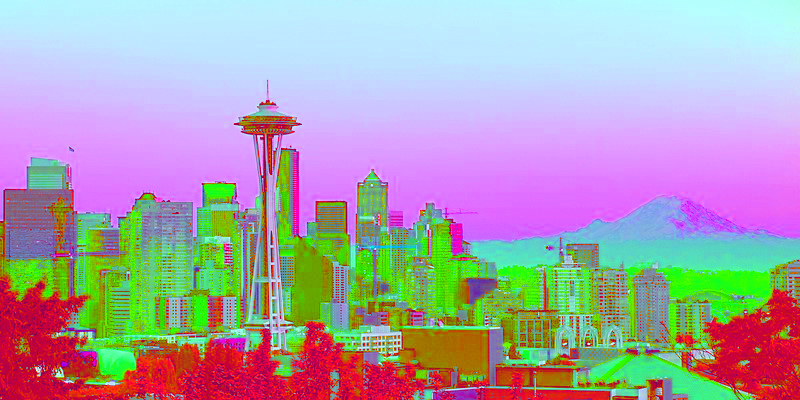
Why does it feel like we are growing so fast?
Bottom Line
- Growth is more visible because it is being forced into the core of the region
- All areas of the region are becoming more densely populated
More visible growth
In the dominant growth pattern of the Post War era, land developers would push out into the farms and forests of unincorporated areas to build massive subdivisions that were mostly invisible to existing residents and would have little impact on them. This growth, which persisted into the current century, was substantial, but barely visible. Moreover, the biggest driver of growth in the 1990s, Microsoft, was a largely suburban phenomenon, similarly less visible to the region.
The Washington State Growth Management Act (GMA) aimed to change this pattern, and has largely succeeded. By drawing an inviolable urban growth boundary (UGB), it contained the invisible spread of growth, and forced new residential and commercial construction into already developed areas. Annexations and incorporations pulled peripheral areas into the “urban” orbit, and developers were encouraged to work with the available land now in cities. Commercial growth, exemplified by Amazon, has favored urban location as well. Weyerhaeuser moved its headquarters from Federal Way to Pioneer Square.
Figure 1 shows how the share of population in unincorporated areas (blue bars) grew through the 1970s, and then gradually diminished as cities grew through annexations, incorporations and native growth.
“Infill” development, whether high-rises in South Lake Union, mid-rises in Renton or construction of new homes on vacant suburban lots, is hard to overlook. And despite heroic (and expensive) efforts to improve transit, infill is having a noticeable impact on traffic congestion.
Becoming more dense
A clearly stated goal of the GMA was to promote higher residential and commercial densities in urbanized areas and, at the same time, ensure very low densities in non-urban areas. There were plenty of grandfathered subdivisions outside the UGBs when they were first drawn, but once those subdivisions were built out, the lot size outside a UGB became a minimum of five acres, and often 20 acres or more. Along the UGB it is not uncommon to see homes on one side of the street and cows on the other side.
The GMA mandates that new development increasingly concentrate in existing urbanized areas, with unincorporated urbanized areas encouraged to annex to adjacent cities. Figure 2 shows density increases in King County and its larger cities from 1990, when GMA was introduced, to 2018.
Within UGBs, densities, and therefore the visual perception of growth, have increased for a variety of reasons.
More multi-family. Across the three-county region, the ratio of single family to multi-family housing has not changed since 1990, with multi-family accounting for just about one third of all units. The locations of that housing have, however, shifted, with King County seeing a higher share of multi-family housing and Pierce and Snohomish seeing a higher share of single family. Since 1980, multi-family units have accounted for 60 percent of all new housing in King County, and over 90 percent of new housing in Seattle.
More urban center mid-rise and high-rise. Land is too expensive for inexpensive walk-up apartments with surface parking. Nearly all new multi-family projects in King County are now mid-rise and high-rise buildings with structured parking. Whereas an older walk-up apartment complex might have 30 units per acre, a new mid-rise or high-rise building may have 150 units or more per acre.
Smaller lot sizes for detached homes. Post-war subdivisions in the region typically offered lot sizes from 7,200 to 10,000 square feet. Lots began to shrink in the 1980s, toward 5,000 to 6,000 square feet. As lots continued to shrink further, the houses themselves started to shrink to fit on lots that would go as low as 3,000 square feet.
Fewer random open spaces. Pre-GMA growth patterns left undeveloped parcels behind as homebuilding moved outward. When the UGA began to restrict land on the periphery, these parcels became attractive to builders. What had been de facto open space that broke up the urbanized environment became more development.
Looking ahead
After nearly 30 years, the UGBs show no sign of moving outward. Within King County single family zoned land is becoming scarce and quite expensive. At the same time, cities have welcomed high density multi-family development and provided ample land for it. The visual and congestion impacts of infill and high density are quite apparent and efforts to mitigate those impacts are falling short. Questions going forward are:
- Can the region continue to grow rapidly through a wider embrace of high density urban living or will the diminishing opportunities to develop traditional single family neighborhoods choke off growth?
- Will the dramatic visibility and congestion impacts of growth in urban areas lead to rebellion and further restrictions on infill?
- Will county governments be pressured into significant expansions of their UGBs?
Discover more from Post Alley
Subscribe to get the latest posts sent to your email.

The idea that suburbs impact traffic less than urban development is backwards. The traffic in Seattle isn’t from urban apartment dwellers, it’s from people commuting in from the suburbs. People drive far more in the suburbs.
I don’t see how expanding the UGA would help anything. All of the jobs are in Seattle or urban king county, so expanding the UGA just means you have people commuting in from further and further away.